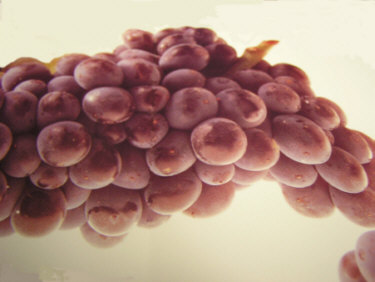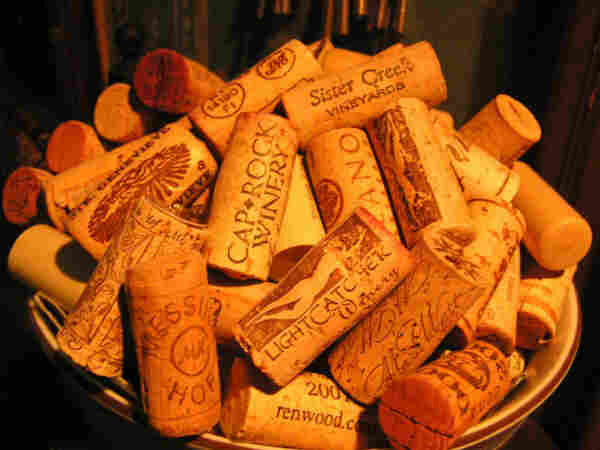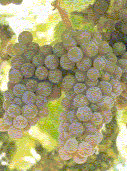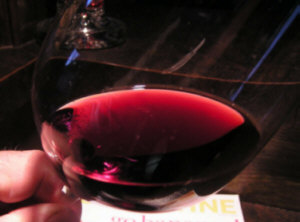
|
|
By Thomas M. Ciesla www.texaswinetrails.com March, 2005 |
|

|
|
|
In the Academy Award winning movie, 'Sideways', two characters, Miles and Maya, wax romantically about the attributes of Pinot Noir while trying to seduce one another by using the characteristics of the Old World grape as a transparent attempt to describe their own vulnerabilities. Maya's breathy diatribe on the pleasures of wine, the fact that it's alive in the bottle and that sadly, it too eventually reaches its peak, is not only sexy as hell, but should be cloned by the wine industry as possibly the best damn commercial ever penned for wine. Whether you consider Miles as a caricature onephile, a money-stealing son, or just a blotto wine drinker – the gist of the movie lies in the homage it pays to this persnickety grape. |
 The Burgundy Wine Region |
Pinot Noir, the definitive grape of the Burgundy wine region in France, has been cultivated since the first century A.D. Today, Pinot Noir is grown in over 20 countries and known in the Old World by many aliases – Pinot Nero in Italy, Blauburgunder in Austria, Spatburgunder in Germany and Burgundac in Yugoslavia. It is also the primary grape of that grand celebratory wine – Champagne. Not bad for a grape with a reputation as being the 'bad boy' of viticulture and winemaking.
Is this reputation founded in reality? Some winemakers say Pinot Noir's reputation as being difficult to grow and ferment is the result of 'sound bites' which wine writers love to regurgitate. They claim that when grown in the proper climate, Pinot Noir is like any other grape. Other winemakers lapse into long soliloquies of how a great harvest one year was followed by multiple year disasters in the vineyard and winery. They'll readily admit that when everything goes right, the resulting wine is pure magic; but seldom does everything go right. |
|
TOO MUCH TROUBLE? |
|
In the vineyard, thin-skinned Pinot Noir demands a remarkable amount of hand labor, requiring someone to deal with each vine individually at least a dozen times a year. In addition, vine growth is not vigorous, often lacking enough leaf cover to protect the grapes from birds. Pinot Noir does best in a cool climate, such as found in the Cote d'Or region of Burgundy, with a long growing season and not too intense sun that allows the grape to reach its full complexity late in the harvest season. Unfortunately, it's this lengthy hang-time that makes the grape vulnerable to damage from rain late in the season.
In the winery, Pinot Noir needs gentle handling to extract all potential color and flavor. Pinot Noir is difficult to ferment, due in part to the presence of 18 naturally balanced amino acids that make the wine ferment violently, often "boiling" out of its vat. This accelerated fermentation process coupled with the grapes thin skin makes color retention a major problem for the vintner. |
|
WORTH THE TROUBLE! A great glass of Pinot Noir is a sensual, almost spiritual experience, unfolding with mouth-watering fruit flavors of blackberries, raspberries, cherries, strawberries and plums. The most appealing quality of Pinot Noir, aside from its wonderful aromatics, is the velvety texture, a liquid silk that caresses the palate with a long smooth finish. But wait a minute – does this sound a bit too much like a line that Miles would say in Sideways? Perhaps. Yet, many folks in the wine business agree that most experienced wine drinkers eventually graduate up to Pinot Noir as the ultimate red wine. With increased knowledge and an experienced palate comes the appreciation for this light, low-tannin red that captures an elegance and grace from the vineyard unlike any other red wine. So a winegrower considering Pinot Noir has to ask one question: Will it be worth the trouble? Considering the rapid expansion of Pinot Noir to the New World wine regions, it apparently is worth the trouble. |
|
|
While the Cote d'Or region in France has been the motherland of Pinot Noir for centuries, modern winemakers in the new world agree that it's worth the trouble as wine regions in America, Australia and New Zealand continue to expand existing vineyards. Of course, this appreciation for New World Pinot Noir didn't always exist; as evidenced in the early the 1990s when restaurants could barely sell the few Pinots they begrudingly agrees to have on their wine lists. At end of the 20th century, however, both harvests and sales of Pinot Noir had tripled. In the United States, wine regions like Oregon's Willamette Valley, California's Central and North Coasts, and to a minor extent, New York's Finger Lakes Region are all producing quality Pinot Noir. In the land down under, New Zealand is the latest hot spot for Pinot Noir, becoming the most planted red grape on that Island nation.
|
|
 |
|
PINOT IN TEXAS So what of Pinot Noir in Texas? Of the 80+ wineries in Texas, only a handful of them produce Pinot Noir. According to Tim Dodd, director of the Texas Wine Marketing Research Institute, "There are less than 100 acres of Pinot Noir in Texas, and just about all of it is grown north of Lubbock." Lubbock is way out there in the northwest plains region of Texas, which includes the Panhandle. The higher altitude allows this region to enjoy the cooler temperatures that Pinot Noir demands. Still, Pinot Noir remains a challenge as Mr. Dodd admits; "the quality from these areas is good, although they have trouble getting good color from the grape." |
|
True to the Texas pioneer spirit, winemakers have done what seemed the impossible by offering Pinot Noirs that stand up against the best in the U.S. Case in point: Paul and Merrill Bonarrigo, owners of Messina Hof Winery and Resort in Bryan, Texas, have been producing award winning Pinot Noirs for decades. As Merrill explains it, "One of the mis-conceptions about Texas is that we have weather too hot for grapes. In the growing regions north of Lubbock, the weather is cool and perfect for Pinot Noir." And while she admits that on of their biggest concerns is spring freeze, the Pinot Noir is rich and full-bodied from those vineyards. The vintners at Messina Hof achieve a rich dark color by flash fermentation, a process where the heat is brought up to set the color, followed by cooling the must down quickly. The end result is in the tasting, as Merrill told me, "we just opened a bottle of our 1994 Pinot Noir and it was just lovely – still full of ripe fruit." Apparently, as with any grape, an experienced hand in the vineyard and in the winery is needed to coax out the best juice.
|
|
THE CURRENT PINOT NOIR CRAZE Unless you've been living in a cave for the last few months, you're probably aware of the impact that the movie Sideways has had on Pinot Noir sales in America. Distributors and winery tasting rooms, particularly in Santa Barbara County, are experiencing anywhere from a 50% to 500% increase in sales since the release of the movie. Is this a good thing for a wine that most agree is not for the weak of pocketbook? Seemingly, the media gods care not! In his Apostolic Letter – 'The Rapid Development…' -- Pope John Paul II recognized the power of the communications media in its ability to spread information and transform humanity into a 'global village', while cautioning on technology's ability to form people's mentality and determine their view of things. Winemakers across America are also witnessing the power of the media, when a single movie inspires almost biblical numbers of people to flock to wineries and stores for a wine they probably had never heard of before seeing Sideways. Suddenly, everyone needed to buy this wine, with no clear reason as to why they should. Of course in these days of grape gluts in wine regions around the world, anything that moves cases of wine is a great thing. But, wine – any wine, varies in quality and this is especially true of a wine made from the recognized 'bad boy' of grapes. All that extra handling in the vineyards and winery equates to higher costs, which is ultimately reflected in the retail price. Many winemakers admit that for a good Pinot Noir, you'll need to spend anywhere from $20 - to - $40 a bottle. What's going to happen to all those folks who buy that $8 bottle and decide after tasting it that they really don't like the stuff and won't buy it again? Could there be a Pinot Noir backlash on the horizon?
|
|
||||
|
Not to worry, there's a way to prevent that from happening; it lies in the pairing Pinot Noir with food. By 2000, Pinot Noir had been transformed into every sommelier's dream of the food-friendliest wine on this planet, with the ability to pair with beef, chicken, fish and shellfish. When paired with a meal, even an $8 bottle of so-so Pinot Noir becomes a 'really nice' bottle of wine. Viola, no backlash!
This brings to mind the scene of that wine-soaked meal in Sideways where four, or was it six bottles of wine were shared between the two couples. I haven't checked the prices on the wines consumed, but something tells me that bar tab may be beyond the incomes of a schoolteacher or waitress -- combined! Of course, stealing from your mother seems to be a profitable endeavor; that 1961 Chateau Cheval Blanc that Miles drank from a Styrofoam cup while at a McDonalds will cost you somewhere between $1,300 and $1,800. Chateau Cheval and McDonalds cuisine? Here's a tasting tip: when dining at McDonalds, try to remember to bring along the sub-$1,000 stuff. And a real glass. Down with Pinot Envy, up with Pinot Enjoyment! |
|||||

